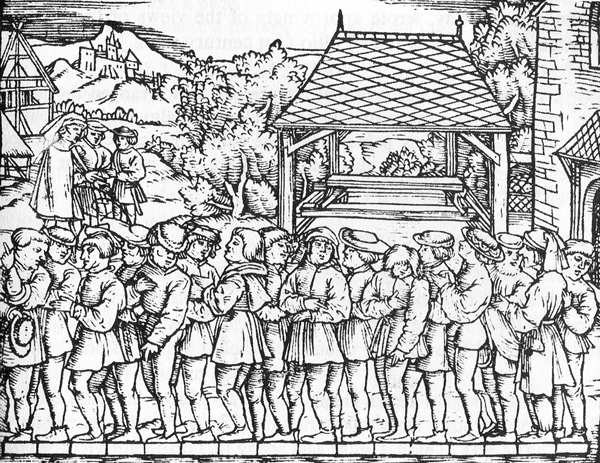|
Yard
The yard (symbol: yd) is an English units, English unit of length in both the British imperial units, imperial and US United States customary units, customary systems of measurement equalling 3 foot (unit), feet or 36 inches. Since 1959 it has been by international yard and pound, international agreement standardized as exactly 0.9144 Metre, meter. A distance of 1,760 yards is equal to 1 mile. The theoretical survey foot, US survey yard is very slightly longer. Name The term, ''yard'' derives from the Old English , etc., which was used for branches, staves and measuring rods. It is first attested in the late 7th century Ine of Wessex#Laws, laws of Ine of Wessex, wherein the "yard of land" mentioned is the virgate, yardland, an old English unit of tax assessment equal to hide (unit), hide. Around the same time the Lindisfarne Gospels account of the messengers from John the Baptist in the Gospel of Matthew used it for a branch swayed by the wind. ... [...More Info...] [...Related Items...] OR: [Wikipedia] [Google] [Baidu] [Amazon] |
English Units
English units were the units of measurement used in England up to 1826 (when they were replaced by Imperial units), which evolved as a combination of the Anglo-Saxons, Anglo-Saxon and Ancient Roman units of measurement, Roman systems of units. Various standards have applied to English units at different times, in different places, and for different applications. Use of the term "English units" can be ambiguous, as, in addition to the meaning used in this article, it is sometimes used to refer to the units of the descendant Imperial system as well to those of the descendant system of United States customary units. The two main sets of English units were the Winchester measure, Winchester Units, used from 1495 to 1587, as affirmed by Henry VII of England, King Henry VII, and the Exchequer Standards, in use from 1588 to 1825, as defined by Queen Elizabeth I. In England (and the British Empire), English units were replaced by Imperial units in 1824 (effective as of 1 January 1826) ... [...More Info...] [...Related Items...] OR: [Wikipedia] [Google] [Baidu] [Amazon] |
Survey Foot
The foot (standard symbol: ft) is a unit of length in the British imperial and United States customary systems of measurement. The prime symbol, , is commonly used to represent the foot. In both customary and imperial units, one foot comprises 12 inches, and one yard comprises three feet. Since an international agreement in 1959, the foot is defined as equal to exactly 0.3048 meters. Historically, the "foot" was a part of many local systems of units, including the Greek, Roman, Chinese, French, and English systems. It varied in length from country to country, from city to city, and sometimes from trade to trade. Its length was usually between 250 mm and 335 mm and was generally, but not always, subdivided into 12 inches or 16 digits. The United States is the only industrialized country that uses the (international) foot in preference to the meter in its commercial, engineering, and standards activities. The foot is legally recognized in the ... [...More Info...] [...Related Items...] OR: [Wikipedia] [Google] [Baidu] [Amazon] |
Foot (unit)
The foot (standard symbol: ft) is a Units of measurement, unit of length in the imperial units, British imperial and United States customary units, United States customary systems of metrology, measurement. The prime (symbol), prime symbol, , is commonly used to represent the foot. In both customary and imperial units, one foot comprises 12 inches, and one yard comprises three feet. Since international yard and pound, an international agreement in 1959, the foot is defined as equal to exactly 0.3048 meters. Historically, the "foot" was a part of many local systems of units, including the Ancient Greek units of measurement, Greek, Ancient Roman units of measurement, Roman, Chinese units of measurement, Chinese, Units of measurement in France before the French Revolution, French, and English units, English systems. It varied in length from country to country, from city to city, and sometimes from trade to trade. Its length was usually between 250 mm and 335 mm and ... [...More Info...] [...Related Items...] OR: [Wikipedia] [Google] [Baidu] [Amazon] |
Acre
The acre ( ) is a Unit of measurement, unit of land area used in the Imperial units, British imperial and the United States customary units#Area, United States customary systems. It is traditionally defined as the area of one Chain (unit), chain by one furlong (66 by 660 Foot (unit), feet), which is exactly equal to 10 square chains, of a square mile, 4,840 square yards, or 43,560 square feet, and approximately 4,047 m2, or about 40% of a hectare. Based upon the International yard and pound, international yard and pound agreement of 1959, an acre may be declared as exactly 4,046.8564224 square metres. The acre is sometimes abbreviated ac, but is usually spelled out as the word "acre".National Institute of Standards and Technolog(n.d.) General Tables of Units of Measurement . Traditionally, in the Middle Ages, an acre was conceived of as the area of land that could be ploughed by one man using a team of eight oxen in one day. The acre is still a statutory measure in the U ... [...More Info...] [...Related Items...] OR: [Wikipedia] [Google] [Baidu] [Amazon] |
Inch
The inch (symbol: in or prime (symbol), ) is a Units of measurement, unit of length in the imperial units, British Imperial and the United States customary units, United States customary System of measurement, systems of measurement. It is equal to yard or of a foot (unit), foot. Derived from the Uncia (unit), Roman uncia ("twelfth"), the word ''inch'' is also sometimes used to translate similar units in other measurement systems, anthropic units, usually understood as deriving from the width of the human thumb. Standards for the exact length of an inch have varied in the past, but since the adoption of the international yard during the 1950s and 1960s the inch has been based on the metric system and defined as exactly 25.4Millimetre, mm. Name The English word "inch" () was an early borrowing from Latin ' ("one-twelfth; Roman inch; Roman ounce"). The vowel change from Latin to Old English (which became Modern English ) is known as Germanic umlaut, umlaut. The consonant c ... [...More Info...] [...Related Items...] OR: [Wikipedia] [Google] [Baidu] [Amazon] |
US Customary Units
United States customary units form a system of measurement units commonly used in the United States and most U.S. territories since being standardized and adopted in 1832. The United States customary system developed from English units that were in use in the British Empire before the U.S. became an independent country. The United Kingdom's system of measures evolved by 1824 to create the imperial system (with imperial units), which was officially adopted in 1826, changing the definitions of some of its units. Consequently, while many U.S. units are essentially similar to their imperial counterparts, there are noticeable differences between the systems. The majority of U.S. customary units were redefined in terms of the meter and kilogram with the Mendenhall Order of 1893 and, in practice, for many years before. T.C. Mendenhall, Superintendent of Standard Weights and MeasuresOrder of April 5, 1893, published as Appendix 6 to the Report for 1893 of the United States Co ... [...More Info...] [...Related Items...] OR: [Wikipedia] [Google] [Baidu] [Amazon] |
Mile
The mile, sometimes the international mile or statute mile to distinguish it from other miles, is a imperial unit, British imperial unit and United States customary unit of length; both are based on the older English unit of Unit of length, length equal to 5,280 Foot (unit), English feet, or 1,760 yards. The statute mile was standardised between the Commonwealth of Nations and the United States by an international yard and pound, international agreement in 1959, when it was formally redefined with respect to SI units as exactly . With qualifiers, ''mile'' is also used to describe or translate a wide range of units derived from or roughly equivalent to the #Roman, Roman mile (roughly ), such as the #Nautical, nautical mile (now exactly), the #Italian, Italian mile (roughly ), and the li (unit), Chinese mile (now exactly). The Romans divided their mile into 5,000 (), but the greater importance of furlongs in the Kingdom of England#Tudor period, Elizabethan-era England meant th ... [...More Info...] [...Related Items...] OR: [Wikipedia] [Google] [Baidu] [Amazon] |
International Yard And Pound
The international yard and pound are two units of measurement that were the subject of an agreement among representatives of six nations signed on 1 July 1959: Australia, Canada, New Zealand, South Africa, the United Kingdom and the United States. The agreement defined the yard as exactly and the avoirdupois pound as exactly . History In October 1834, the British Houses of Parliament were destroyed in a fire. Among the items lost were the objects that defined the imperial standards of length and mass. New prototypes were subsequently created to replace the items lost in the fire, among them a new "yardstick" ruler in 1855, and with it a new formal definition of the yard. Two copies of the ruler were subsequently presented to the United States, which in turn adopted the measure for the United States national standard yard. In 1866, the U.S. Congress passed a law that allowed, but did not require, the use of the metric system in trade and commerce. Included in the law was a tab ... [...More Info...] [...Related Items...] OR: [Wikipedia] [Google] [Baidu] [Amazon] |
Imperial Units
The imperial system of units, imperial system or imperial units (also known as British Imperial or Exchequer Standards of 1826) is the system of units first defined in the British Weights and Measures Act 1824 and continued to be developed through a series of Weights and Measures Acts and amendments. The imperial system developed from earlier English units as did the Comparison of the imperial and US customary measurement systems, related but differing system of United States customary units, customary units of the United States. The imperial units replaced the Winchester measure, Winchester Standards, which were in effect from 1588 to 1825. The system came into official use across the British Empire in 1826. By the late 20th century, most nations of the former empire had metrication, officially adopted the metric system as their main system of measurement, but imperial units are still used alongside metric units in the United Kingdom and in some other parts of the former empi ... [...More Info...] [...Related Items...] OR: [Wikipedia] [Google] [Baidu] [Amazon] |




